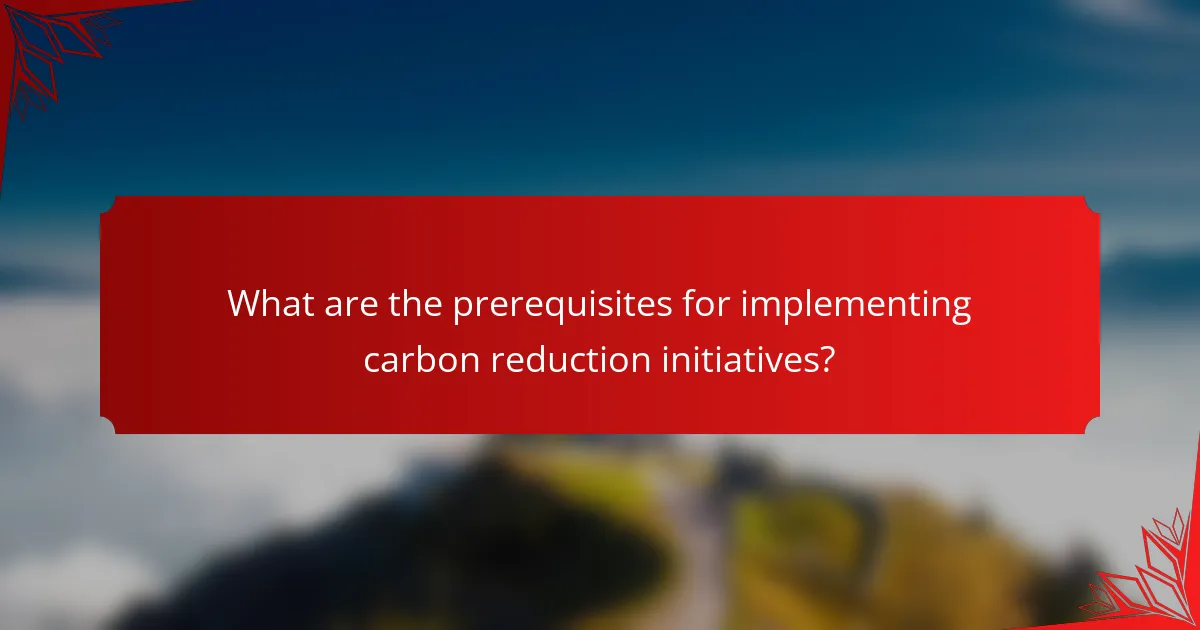Carbon footprint reduction initiatives in the United States encompass diverse strategies designed to lower greenhouse gas emissions, including renewable energy adoption, enhanced energy efficiency, and sustainable transportation practices. Businesses assess the effectiveness of these initiatives through various evaluation methods, which help identify strengths and areas for improvement. By employing specific metrics to quantify emissions, energy use, and cost savings, organizations can gain a clearer understanding of the impact of their carbon reduction efforts.

What are effective carbon footprint reduction initiatives in the United States?
Effective carbon footprint reduction initiatives in the United States include a range of strategies aimed at decreasing greenhouse gas emissions. These initiatives focus on renewable energy, energy efficiency, sustainable transportation, waste reduction, and carbon offset programs, each contributing to a more sustainable future.
Renewable energy adoption
Renewable energy adoption involves transitioning from fossil fuels to sources like solar, wind, and hydroelectric power. This shift not only reduces carbon emissions but also promotes energy independence and job creation in the green sector.
In the U.S., states like California and Texas lead in renewable energy generation, with solar and wind installations significantly increasing in recent years. Homeowners can also participate by installing solar panels, often benefiting from tax credits and incentives.
Energy efficiency programs
Energy efficiency programs aim to reduce energy consumption through improved technologies and practices. These initiatives can include upgrading insulation, using energy-efficient appliances, and implementing smart home systems.
Programs such as ENERGY STAR provide guidelines and certifications for energy-efficient products, helping consumers make informed choices. Businesses can also benefit from energy audits that identify areas for improvement, potentially saving them significant costs on utility bills.
Sustainable transportation options
Sustainable transportation options focus on reducing emissions from vehicles through public transit, biking, walking, and electric vehicles (EVs). Encouraging these alternatives can lead to lower carbon footprints for individuals and communities.
Many cities are investing in bike lanes and public transit systems to promote these options. Additionally, federal and state incentives for purchasing EVs, such as tax credits, make them more accessible to consumers, further supporting a shift toward sustainable transportation.
Waste reduction strategies
Waste reduction strategies aim to minimize landfill contributions by promoting recycling, composting, and reducing single-use plastics. These practices not only cut emissions associated with waste processing but also conserve resources.
Communities can implement programs that encourage recycling and composting at home and in businesses. Simple actions, like using reusable bags and containers, can significantly reduce waste and inspire others to follow suit.
Carbon offset programs
Carbon offset programs allow individuals and businesses to compensate for their emissions by investing in projects that reduce or capture greenhouse gases. These can include reforestation, renewable energy projects, and methane capture initiatives.
Participating in carbon offset programs can be an effective way to achieve carbon neutrality. Many organizations offer verified offsets, ensuring that contributions lead to real environmental benefits, making it easier for consumers to make a positive impact.

How do businesses evaluate carbon footprint reduction initiatives?
Businesses evaluate carbon footprint reduction initiatives by using various methods to measure and analyze their emissions. This evaluation helps organizations understand the effectiveness of their strategies and identify areas for improvement.
Carbon accounting methods
Carbon accounting methods involve quantifying greenhouse gas emissions associated with a business’s operations. Common approaches include the Greenhouse Gas Protocol and ISO 14064, which provide frameworks for measuring emissions across scopes, such as direct emissions from owned sources and indirect emissions from purchased electricity.
Organizations often use software tools to automate data collection and reporting, ensuring accuracy and compliance with regulations. Regular audits and updates are essential to maintain reliable carbon accounting practices.
Life cycle assessment
Life cycle assessment (LCA) evaluates the environmental impacts of a product or service throughout its entire life cycle, from raw material extraction to disposal. This comprehensive approach helps businesses identify hotspots where emissions can be reduced, guiding more sustainable decision-making.
When conducting an LCA, companies should consider factors such as resource use, energy consumption, and waste generation. Engaging stakeholders in the process can enhance the assessment’s accuracy and relevance.
Benchmarking against industry standards
Benchmarking against industry standards allows businesses to compare their carbon footprint reduction initiatives with peers. This process can highlight best practices and reveal gaps in performance, motivating organizations to adopt more effective strategies.
Common benchmarks include sector-specific emissions reduction targets and sustainability certifications. Companies should regularly review their performance against these standards and adjust their initiatives accordingly to stay competitive and compliant.

What metrics are used to measure the effectiveness of carbon reduction efforts?
To measure the effectiveness of carbon reduction efforts, organizations typically use a combination of metrics that quantify greenhouse gas emissions, energy consumption, and cost savings. These metrics provide a comprehensive view of the impact of initiatives aimed at reducing carbon footprints.
Greenhouse gas emissions reduction
Greenhouse gas emissions reduction is a primary metric for evaluating carbon reduction initiatives. This metric often involves measuring the total emissions in CO2 equivalents, allowing for a standardized comparison across different gases. Organizations may track reductions over time, aiming for targets aligned with national or international agreements.
Common approaches include using baseline emissions data to establish a starting point and then monitoring changes through regular reporting. Tools like carbon calculators can help organizations estimate their emissions and track progress toward reduction goals.
Energy consumption metrics
Energy consumption metrics assess the total energy used by an organization and its sources, such as renewable versus non-renewable energy. This metric is crucial because reducing energy consumption directly correlates with lowering carbon emissions. Organizations often aim to improve energy efficiency through upgrades and behavioral changes.
Key indicators include energy use intensity (EUI), which measures energy consumption per unit of output, and the percentage of energy sourced from renewables. Regular audits can help identify areas for improvement and track progress over time.
Cost savings analysis
Cost savings analysis evaluates the financial impact of carbon reduction initiatives, helping organizations understand the economic benefits of their efforts. This analysis often includes comparing energy costs before and after implementing energy efficiency measures or renewable energy projects.
Organizations can also consider potential savings from government incentives or tax credits related to sustainability initiatives. A thorough cost-benefit analysis can reveal the return on investment (ROI) for various carbon reduction strategies, guiding future decisions.

What are the prerequisites for implementing carbon reduction initiatives?
Implementing carbon reduction initiatives requires a clear understanding of the necessary prerequisites, including stakeholder engagement, regulatory compliance, and a baseline emissions assessment. These elements ensure that initiatives are effective, measurable, and aligned with broader environmental goals.
Stakeholder engagement
Effective stakeholder engagement is crucial for the success of carbon reduction initiatives. It involves identifying and involving all relevant parties, such as employees, local communities, and investors, in the planning and implementation processes. Engaging stakeholders fosters collaboration and can lead to innovative solutions that enhance the initiative’s effectiveness.
To facilitate engagement, organizations can conduct workshops, surveys, or informational sessions to gather input and build support. Regular communication helps maintain transparency and encourages ongoing participation, which is essential for long-term success.
Regulatory compliance
Regulatory compliance is a fundamental prerequisite for carbon reduction initiatives, as it ensures that organizations adhere to local and national environmental laws. Understanding the specific regulations that apply to your industry is vital, as non-compliance can result in penalties and damage to reputation.
Organizations should familiarize themselves with relevant standards, such as the ISO 14001 for environmental management systems, and any local emissions regulations. Consulting with legal experts or environmental consultants can help navigate complex regulatory landscapes and ensure that initiatives align with legal requirements.
Baseline emissions assessment
A baseline emissions assessment establishes the starting point for measuring the impact of carbon reduction initiatives. This assessment involves quantifying current emissions across various sources, such as energy use, transportation, and waste management. Accurate data is essential for setting realistic reduction targets and tracking progress over time.
Organizations can utilize tools like carbon calculators or engage third-party auditors to conduct thorough assessments. Regular updates to the baseline assessment are necessary to reflect changes in operations or emissions sources, ensuring that reduction efforts remain relevant and effective.

How do carbon footprint reduction initiatives compare across different sectors?
Carbon footprint reduction initiatives vary significantly across sectors, influenced by their operational characteristics and regulatory environments. Corporate initiatives often focus on large-scale emissions reductions, while residential efforts tend to emphasize individual behavior changes and energy efficiency.
Corporate vs. residential initiatives
Corporate initiatives typically involve comprehensive strategies such as adopting renewable energy, enhancing energy efficiency, and implementing carbon offset programs. These measures can lead to substantial reductions in greenhouse gas emissions, often quantified in terms of total emissions avoided or reduced over time.
In contrast, residential initiatives focus on smaller-scale actions like improving home insulation, using energy-efficient appliances, and reducing vehicle usage. While the impact of individual households may seem minor, collectively, these actions can contribute significantly to national and global emissions targets.
To maximize effectiveness, both sectors should consider their unique challenges and opportunities. Corporations can leverage technology and economies of scale, while residential initiatives can benefit from community engagement and education. A balanced approach that includes both corporate and residential efforts is essential for meaningful carbon footprint reduction.



